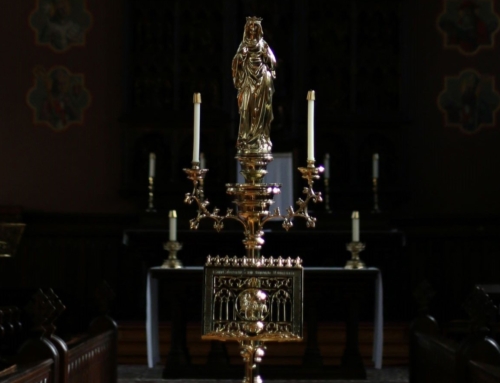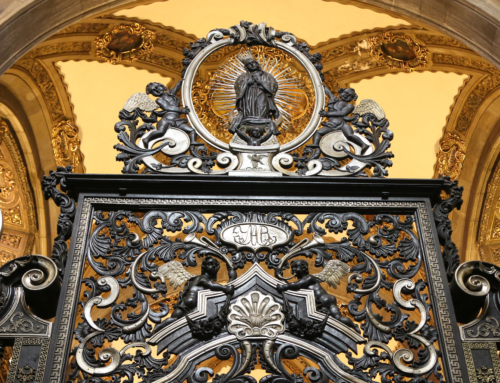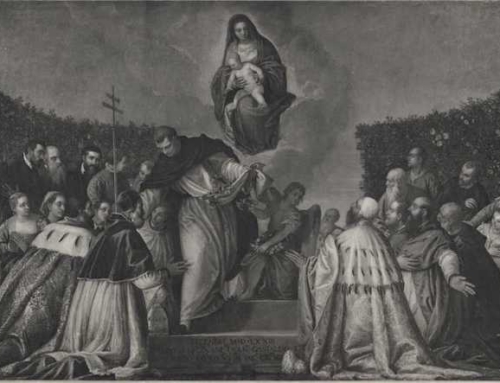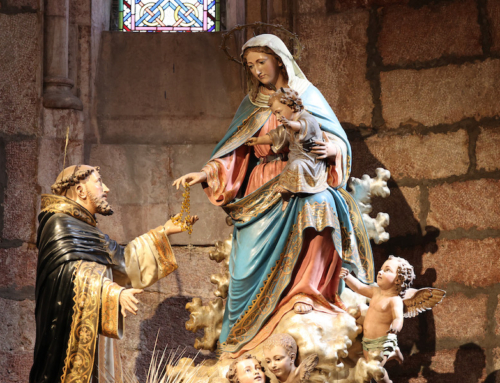“April showers bring May flowers.” You remember that little rhyme, don’t you? Growing up in Buffalo meant that sometimes these showers were of the snowy variety, but those flowers did spring up in May. And at my house there were plenty of them, especially roses, my mother’s favorite part of the garden. But May is not just the month of spring flowers; it is also the month of Mary. And the connection of Mary and the flowers of May, especially roses, is admirably fitting.
First, roses don’t come fully grown. They, too, start out as small seeds. But these seeds have a destiny—they have been preordained to flower into one of the most sought-after natural beauties. These beautiful flowers are hidden away, buried in the earth, waiting for the “appointed time” to appear. Mary, too, did not come unto the salvation history fully grown. Her beginnings go back into the midst of time, as Lumen Gentium says: “she is already prophetically foreshadowed in the promise of victory over the serpent which was given to our first parents after their fall into sin” (LG 55). Mary was chosen and hidden “before the foundation of the world” (Eph. 1:4); a seed of the redeemer to come.
Second, even when the seed turns into a bulb and begins to grow out of the soil it is not yet anything like a rose: stem, thorn, and leaves resemble not a rose. And thorns can be quite tricky to work with. Mary’s coming too was not without thorns and ugliness. Tradition ascribes the genealogy of Jesus found in Matthew to Mary’s lineage, and the cast of characters found there are not all of the pious type. Abraham lied about his wife to Pharaoh, Jacob tricked his father, Tamar deceived her father-in-law into sleeping with her, Rahab is a prostitute in Jericho, the incident with David and Bathsheba is well known, Rehoboam breaks up the kingdom of Israel, Manasseh brings about the Babylonian exile, and so on. This is truly a thorny line of descent—a line of royalty, rancour, yet also repentance. This is no problem for God; he chose Mary from the beginning and worked through the rough and tumble of Israelite history to get to her.
Third, it always seemed like one morning the rose flowers just appeared. When the buds arrived you got a foretaste of future glory, but it was always a decisive moment in the garden when the outer leaves fell away, revealing the most beautiful flower. So too with Mary: the stories of her childhood are all tradition-based and shrouded in legend, but obviously this Jewish girl was no ordinary child. As the Protoevangelium of James records: “She made a sanctuary in her bed-chamber, and allowed nothing common or unclean to pass through her.” Yet no one, not even Mary, was ready for the Annunciation, the moment when “Mary is definitively introduced into the mystery of Christ” (Redemptoris Mater, 8). Mary’s Fiat is the opening of the flower of God’s salvation.
Fourth and finally are the color and smell of this beautiful flower. While there are many colors created through cross breeding, it is the natural red roses which have the sweetest perfume. My mother always said you had to choose between the eyes and the nose; you can’t have wild colors with pungent aromas. So too with Mary, for it is only by the redemption wrought in Christ that she has any special holiness and power. Her “salvific influence…flows forth from the superabundance of the merits of Christ, rests on His mediation, depends entirely on it and draws all its power from it” (LG 60). The Catechism summarizes this Mother-Son relation nicely: “What the Catholic faith believes about Mary is based on what it believes about Christ, and what it teaches about Mary illumines in turn its faith in Christ” (CCC 487). Bl. John Henry Cardinal Newman says the same: “The glories of Mary are for the sake of Jesus… we praise and bless her as the first of creatures, that we may duly confess Him as our sole Creator.” Separating the redemptive role of Christ from Mary is akin to breeding a rose with a color other than red: no matter how beautiful this new hue, the rose will lack that wonderful fragrance, the analogical “aroma of Christ” which we venerate in our devotion to Mary.
Mary is, as the Litany of Loretto has it, the Rosa Mystica, the Mystical Rose, the Flower of May. Cardinal Newman, in his reflections on the Litany, sums this up beautifully:
Mary is the most beautiful flower that was ever seen in the spiritual world. It is by the power of God’s grace that from this barren and desolate earth there have ever sprung up at all flowers of holiness and glory. And Mary is the Queen of them. She is the Queen of spiritual flowers; and therefore she is called the Rose, for the rose is fitly called of all flowers the most beautiful.
This month, Mary’s month, spend some extra moments in the rose garden of Marian devotion, for it is there that Christ loved, and still loves, to dwell fragrantly.
✠
Photo Credit: Joseph Chen, O.P.







